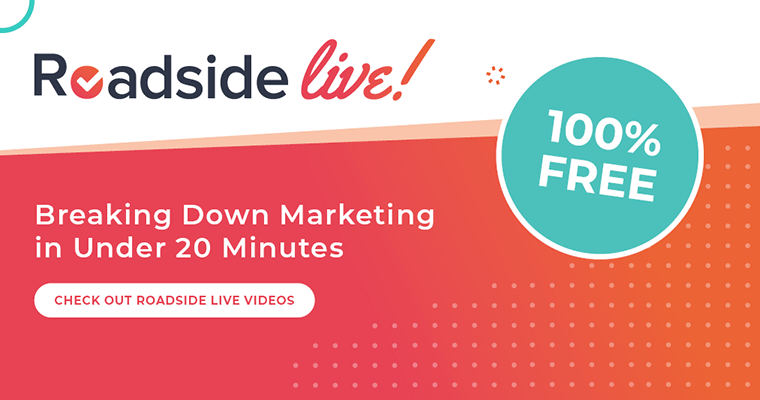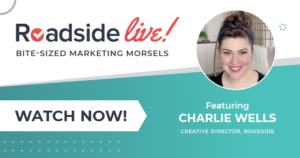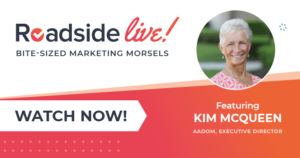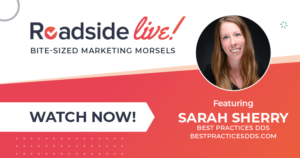2021 Google Updates: What to Do Now to Be Prepared [VIDEO]
On our latest episode of Roadside Live, Angela is joined by our very own SEO experts, Kelsey and Alex, to discuss important Google algorithm updates that will be affecting everyone very soon.
Watch our easy-to-digest video below, and you’ll learn:
- What “Core Web Vitals” are and why they will become even heavier ranking factors than they already are
- What Google looks for when determining which websites to rank
- Why a mobile-first user experience is critical for 2021
- How to determine if your website is ready for this upcoming Google update
- What to do if you are bombarded with scary emails from SEO companies
Angela: Well, hello everybody. Thank you for joining us for another … This text opens a new tab …Facebook Live session. Today we’ve got two of our own team members joining us. So I’d like to introduce Kelsey and Alex. They are part of our SEO team and they have some great information on some changes that we’re going to be seeing in 2021 and how it affects websites, how it affects ranking, and why everyone should care about it.
So Google updates is our subject, and we know that every few years, well, actually probably more frequently than that, but every couple of years, Google makes some pretty major algorithm updates and this is another one that we know is coming. So let’s start. I’ll kind of bounce back and forth between my two experts here in asking questions.
Kelsey, can I start with you? What are the core web vitals that we’ve been hearing so much about, when do they come out, and why should we care about them?
Kelsey: Well, these web vitals are metrics used to measure somebody’s experience with your website. They’re not new, actually. They were released middle of last year, but now they’re becoming more important. Google recently announced that coming in 2021, they’re going to become part of their ranking algorithm. So they’re becoming more important than what they were before.
They’re made up of three main metrics. One is measuring your loading time. The other one is your interactivity. So – how long does it take before someone can actually do something on your website? Can they scroll down or can they click on something on your site? And then the other one has to do with your visual stability or being able to have something. If maybe the items are too close together, or you’re trying to close something, or you’re trying to buy something or trying to do something, but you can’t physically click on it because something else is in the way.
Angela: Oh, that is so annoying. That is the worst!
Kelsey: And it happens all the time and these three different metrics are broken down into what’s called an LCP, or Largest Contentful Paint. It measures your main elements, your loading performance for key visual elements, whether that be your navigation, your font styles, maybe main images, your logo, et cetera.
You want that particular metric to be around two and a half seconds. That’s your ideal goal to have that load in that percentage of time, especially if you’re on a mobile device, maybe you’re on a slower connection, something like that. You want to be able to have your site display fast.
The second metric is referred to as your first input delay. So this also has to do with loading. But it’s a little bit different because now it’s measuring how quickly someone can do something on your site. So the metric here is obviously a little bit faster. You don’t want to wait two and a half seconds before you can scroll or click on something. You want that to be as fast as possible.
The goal on this one is about a hundred milliseconds, give or take. Obviously for some sites, some verticals it’s going to be a little bit longer. It’s just the way it is.
The third metric is the cumulative layout shift. And that’s the one that has to do with the visual stability or those different elements working together and/or blocking one another from being able to interact. So another example: If you go to tap on a page and then it’s gone or it moves, or if you tap on something that’s supposed to drop down, but it doesn’t, or now it drops off and then it blocks something behind it, and you’re literally left not being able to interact with that site, which of course leaves it as a poor experience.
So those are the three metrics that were already in place, but now they’re becoming more important, more crucial to focus on.
Angela: So a lot of those things that you described sound a little bit more on the technical side. Like as a user, being the doctor, or being the practice administrator, I understand page speed. I understand the concept of all of those things you’re talking about, but I may not really understand the specifics of it.
But I know that what is going to be important to them is: How are these changes or these updates going to affect rankings? How important is it going to be? How much do they need to care about it?
Kelsey: Yeah. I mean, it’s going to affect it quite a bit and I’ll let Alex jump in a little bit later on that, but these metrics are gauging the experience – the overall experience someone’s having with your site.
It’s gone beyond simply having great content. It’s gone beyond being the authority in your world or your domain. Now, it’s about providing the absolute best experience for someone who wants to learn that content that wants to read that content that wants to assimilate that content. It’s taking that end-user experience, not just providing something, but now it’s – how do you provide it? How are you giving?
Now, it’s about providing the absolute best experience.
Angela: Okay, thank you.
So, Alex, I’ll let you take a turn here. Kelsey was talking a lot about the user experience, page speed. Can you dig a little deeper into how that’s going to affect SEO or why it would affect SEO?
Alex: Yeah. And I’ll back it up for a second and think of it from the Google side of things. If you think about Google’s overarching goal as a search engine provider, the way they’re going to be successful, the way they’re going to make money, and the way they’re going to retain their users, which they’ve done a fantastic job of by the fact that Google is a verb and we all just know it means “the internet.”
Those are pretty standard, but they have to remain there because if they start to allow sites with a poor user experience or with inaccurate results or false information or with harmful information to rank, then they’re gonna stop making money. So the overarching goal for Google is to provide the best results and the best experience online.
And that is how they continue to create the best experience for their customers. So everything that we can do to align our site and our standards with Google’s overarching goal, because it really should be the same goal for us or for our practice, for our site, for our customers, for our patients, is creating a great user experience.
So that’s the reason that SEO factors into this. There’s a lot of specific ranking factors, but overall, we want to create a better user experience, not just for SEO, but just for conversion in general. It creates a better experience with our brand.
But some of the specific ranking factors include that over 70-80% of most of your customer base, your patient base, is viewing your site on their mobile device.
So if you haven’t revisited that for a while, there’s a good chance that there may be something not optimized or not loading efficiently or not moving very fast on a mobile device, especially with a standard 3G connection. Something to consider and look into is, how fast is it loading on a mobile device?
That’s all part of this user experience update that will be rolling out in May 2021. Also, if your site isn’t HTTPS secure, that little SSL certificate at the top of your URL, nowadays it’s a standard across every website because all information that we’re sharing needs to be secured. It may not be 100% confidential by any means, but we really want to make sure that the sites that we’re on are secure and that we can trust them, and so Google uses that as a ranking factor as well.
They’re also measuring if there are any intrusive interstitials, for example, if there are any abrasive popups, loads of popups, or the way things are loading. I think we’ve all been on sites – perhaps we’re trying to look up a recipe and it’s just ad after ad after ad, or popup after popup – it’s impossible to actually read what’s on the page or absorb any content.
And so, although there is some balance there, maybe a pop-up to get some lead captures may be still fine, but we definitely want it don’t want to overdo it and we want to be conservative to make sure we’re only using it when we need to.
But Google is analyzing all of these things and kind of packaging them into the core web vitals and the user experience update to make sure that everybody creates the best experience online and that’s the new standard.
And the other thing to keep in mind is that it’s not actually new. Kelsey brought this out, this new update that’s coming up in May 2021, it’s more of a “public release” that Google can use so that internal teams can leverage that to get the buy-in that they probably haven’t been able to do for awhile, but they currently are ranking factors.
So if you’re thinking, “Oh, well, let’s put it off for six months or a year because it’s not going to happen for a little while,” it’s actually happening right now. So if your site isn’t up to date, if it’s not modern, if it’s not responsive, if it’s not loading effectively, there’s a good chance that it’s affecting your performance in SEO.
If your site isn’t up to date, if it’s not modern, if it’s not responsive, if it’s not loading effectively, there’s a good chance that it’s affecting your performance in SEO.
Angela: Okay, so how could a practice improve these things? What would their goal be in seeing those things improve?
Alex: So, like Kelsey mentioned with page speed, anything around two and a half seconds or less is always a pretty good goal and a marker. There’s a lot of different things that roll into that and can factor into that. If you have a lot of images, if you have a lot of videos playing on the site, those types of things are gonna slow down the site. But they also create a good user experience sometimes. So there’s a little bit of a balance, some of those things are beneficial. I think sites with really amazing photography, clean and crisp photos, really stand out, but they don’t always have to be as large as people put them on the site, often their file size can be condensed quite a bit. Some of that stuff that happens on the back end.
And then again, making sure that your site looks great on a mobile device. If you haven’t done it in awhile – if you’ve only been visiting your site from a desktop computer, because that’s what you’re using at work – pull up your phone and check out your site on your phone and see: Does your site still look great on a mobile device? Are all the same images there? Is it the same URL? Is anything changing?
Because that’s actually how Google is indexing sites now, mobile-first. The way Google is approaching websites is actually looking at it from the mobile device first, and not the desktop. So, if something is missing on the mobile device, Google’s possibly not even indexing or not even reading it themselves because they’re only looking at the mobile version as that’s where 70-80% of your patient base is viewing your site as well.
The way Google is approaching websites is looking at it from the mobile device first, not the desktop.
Angela: Yeah, that’s really interesting. I’ll give you a break – thank you for all that – I’ll jump back to Kelsey for a second.
Kelsey, I know with our clients, that’s something we’ve been considering in our development for quite a while, and I know that we’re revisiting it for all of our clients based on this update, but what if someone is not a client of ours, of Roadside?
How would an office manager or a practice know if their site needs attention? How would they judge if they need to do something? Do they need to be more proactive?
A lot of the things you guys described, some of them, yeah, we totally can track ourselves, but some of it sounds like more technical stuff that I, as an office team member, I wouldn’t know.
So what would you recommend to the practices that are working with other agencies? How can they make sure their website’s going to qualify and they’re not going to get penalized in May?
Kelsey: The easiest way to do that is to simply ask your agency: “What is your plan of action? Where’s my site right now? What are your goals and what do you have in the plan to get it where it needs to go?”
If you’re a little bit savvy yourself, if you want to try to test it yourself and see those stats or see those metrics, you can use the … This text opens a new tab …Google Page Speed developers’ tool or the … This text opens a new tab …Google Lighthouse tool. And you just simply just put in your domain and run the scan.
Obviously looking at those metrics that come back, you may not be able to translate all of them or understand all of them, but you’ll be able to see, okay, green, yellow, or red, what do I need to work on? What do I need to improve?
Alex mentioned something to keep in mind that if your site’s a couple of years old, chances are it already has room for improvement and/or it was built in a way that was good or optimized for that particular time. Maybe you’ve got eight different fonts that are being used on your site, or maybe you’ve got 23 megabytes of images because you took fantastic photos, right? And that’s great, but is that delivery now of that content still the best way to give it to your patients, or give it to the people that are coming to your website?
So you can do a physical, technical audit, but also just a visual audit of your site and see if there’s anything that could be improved.
If your site’s a couple of years old, chances are it already has room for improvement.
Angela: So I’m gonna put you guys in the hot seat a little bit for a minute and play devil’s advocate. I’m gonna take myself out of the Roadside role and put myself as someone in the practice. My website is maybe two or three years old, but we invested a substantial amount of money to make a very cool site, you know, three years ago. And now we’re being told Google has changed again and we have to do something different.
Some offices get a little frustrated. Like why are we not able to keep up with the changes?
How would you explain to an office that is feeling frustrated by the fact that if their site is only two years old, why do they have to do something to it again?
Alex, I’ll put you on the spot first. What would you say? Because I know I hear that, and you guys probably do also.
Alex: Yeah. And in some cases, it needs to be improved, and in other cases, it might need to be redone. And the best analogy I can think of for that is: When was the last time you bought a new phone?
I mean, we think about how often phones’ technology goes out of date. And that’s something we are more than happy to spend a thousand dollars on or more – the new iPhone – because we like it! But often after two years, three years, they slow down, they stop working. But because we’re all using it on a daily basis, on a regular basis, we’re willing to invest that.
So if you’re a business that is not investing in and re-evaluating something that’s being used and viewed and evaluated by hundreds or thousands of patients on a regular basis – on a daily basis, on a monthly basis – it’s a serious thing to consider. Because if we’re willing to invest in a new phone every couple of years, there’s a pretty good indication that our site needs to get revisited as well.
Angela: Okay, that’s fair. I get that. I’m guilty of wanting the new shiny phone as soon as it comes out.
So Kelsey, I know that historically, Google has made some big algorithm changes, and when that happens I hear from the practices that get bombarded with scare tactics. Everyone that you can imagine is blowing up their email and calling their phone and saying the sky is falling, their website’s going to blow up, and they’re going to go completely invisible.
So, what would you say to that? How much legitimacy is there to that? Is it just a way to drum up business, or are they actually evaluating people’s websites?
Kelsey: Yeah – without a doubt, absolutely, you’re going to get these emails. These agencies seem to just come out of the woodwork and they blanket with a template email that looks and reads the exact same way for every single person they send it to.
Now on the surface, is it a bad thing? No, as Alex and I mentioned, it is a factor and it is going to be something that’s taken into consideration for where their website is going to rank. But is the sky falling? No, it’s not. So when you get these emails – and you will, you’ll get them – the easiest way is, again, to go back to your agency.
Talk to them – have a real conversation and say, look, here’s what this says. Where am I currently? What are your goals? Where am I going to be? Or what is a realistic expectation?
Just because the ideal statistic or the ideal metric is “this” by Google, you may not fall into that category and neither will your competitors.
So, find out specifically: For where you are, what should be your expectations? And then put a plan in action.
Angela: So that actually brings me to one other quick question that I didn’t ask, but primarily our audience is the dental, medical, healthcare field, but this algorithm update, this change, it’s not necessarily targeting medical healthcare practices in general, it’s across the board. So do either one of you have any other opinion on how much it affects every website, and how much it affects healthcare and dental practices specifically?
Kelsey: Maybe Alex will have something to jump in on that, but I will say it’ll probably have a heavier effect on e-commerce sites – sites that are physically trying to sell goods and/or have a high rate of interactivity, those types of sites will probably be more affected.
But it will affect the dental and medical fields. They have a lot of images. You have videos, you have these sources that do slow down a site. So there will be an effect on these types of websites as well.
Alex: And to follow up on Kelsey’s point there, there’s kind of a bucket that Google classifies as ultra-sensitive industries. So they place high priority because if they create inaccurate or false results, it actually causes serious damage or potential harm to people. I know that some of the top engineers at Google who are public-facing on Twitter talk about the negative effects of if somebody is looking for doing cancer research for a sick relative or for themselves and they get some inaccurate pill that somebody is trying to sell or some, some false research, that can kill somebody or negatively affect them. That’s an ethical, serious decision that Google has to weigh themselves.
And so in the same way, anything that affects your money or your life, they place a little bit more weight on. Now it’s a little bit different in the dental or medical industry, depending on the type of information we’re putting out. You know, we’re not WebMD, necessarily. But we do put out medical information or helpful information and insights, explaining services, providing services for people, and Google does take it a little bit more seriously than if you’re some random blog about a random topic that’s less weighty. And so this does affect the medical and dental industry, as well as e-commerce – essentially anything where money changes hands, or advice that affects your health or your life in some serious way like that.
Angela: And thankfully most of our medical dental practices are not going to have ads on their sites, so that is one of the things that we’re not worried about for our medical practices – having pop-up ads or having things like that. So that’s one benefit of the field we’re in.
So just to summarize, I know that as a company, we are looking at our own clients’ websites and doing a real deep-dive analysis to make sure all of them are up to date and we’re staying proactive.
But for anyone else in the community, we’re offering website audits – basically, these two gentlemen right here are the two that are doing the work. If you want to have an analysis on your website – how is it doing? We are doing a complimentary, no-obligation website analysis. You can just simply reach out to us and ask us to evaluate your site and how it’s performing. We’ll give back a complimentary report and you can decide from there, if there are any changes that need to be made based on that for 2021, or if you are sitting pretty.
Feel free to reach out to us as a company and I’ll be happy to set up the tasks and let these two gentlemen do all the research for you, and then I will report it back to you. We’re happy to help!
Thanks, Alex and Kelsey for taking time today. I know a lot of our audience has been asking about this, they’ve been hearing already the hubbub that there’s going to be a change, and that always makes people start to get a little nervous and anxious. So thanks for taking the time to break it down!




